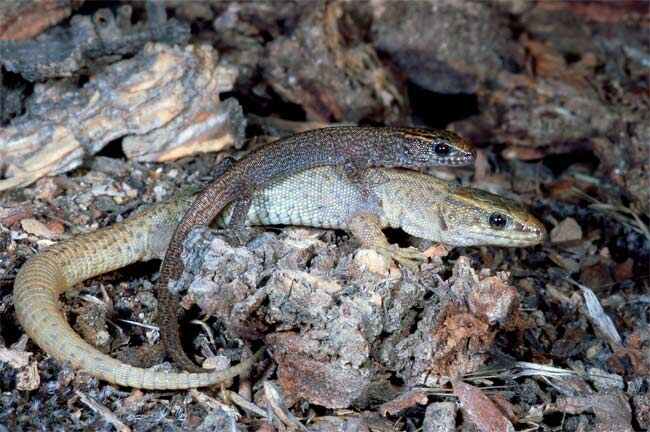Hey Lizard Face, Want to Join My Social Group?

Lizards have been discovered in the Mojave Desert that, like us, live in families and give birth to live young.
The fact these reptiles give birth to live young could explain why they live in families, researchers suggest.
Evolutionary biologist Alison Davis, a postdoctoral researcher at the University of California, Berkeley, investigated desert night lizards (Xantusia vigilis). These unusual reptiles are viviparous, giving birth to live young instead of laying eggs, and rather than being loners prefer to stick together in family groups.
"Night lizard is actually a misnomer," Davis said. "When the species was first discovered in the mid-1800s, scientists initially assumed that they must be nocturnal for two reasons — they had vertical pupils like a cat, which is quite common among animals that are active and need to see well at night, and scientists never saw these particular lizards running around during the day, even though many other lizard species are quite conspicuous and like to bask in the sun. Thus, they named them night lizards."
Only later did scientists discover they are not nocturnal.
"They are just incredibly secretive, and they hide all the time underneath fallen logs, rocks, and other debris and rarely move outside of these cover objects, which is why no one ever saw them out and about," Davis said. "It's pretty dark underneath logs even during the day, so vertical pupils help them see better in this low-light environment — but they're not actually night lizards after all."
Hidden under Joshua trees
Get the world’s most fascinating discoveries delivered straight to your inbox.
When Davis was a graduate student at the University of California, Santa Cruz, she found young and old lizards huddling together every winter beneath fallen Joshua trees and other desert plant debris.
"Very little research had been done on these lizards since the 1960s, but one paper from that time period mentioned that researchers found multiple lizards underneath single logs in the winter," Davis recalled. "So I went out into the desert to look for these fabled groups underneath Joshua tree logs, and I didn't have to find many before I started to see a pattern — the groups often contained one adult female, one adult male, and babies of several different ages."
Genetic analyses of these reptiles revealed the young lizards stayed with their mother, father and siblings for up to three years after birth. (The lizards have a life span of up to 8 to 10 years.) Some groups stuck together under the same fallen log year after year, forming what the researchers termed dynasties.
"This is remarkable, given the fact that in most species of lizards, individuals actively avoid each other," Davis said.
Some 20 lizard species are thought to form family groups. Only two of these lay eggs. This suggests that viviparity, or live birth, is crucial for the evolution of such family ties.
"Giving live birth instead of laying eggs allows mothers and offspring to interact, and we propose that this is how babies end up staying with their parents in the first place," Davis told LiveScience. "In lizards, live birth predisposes an animal to form a family group."
How to capture a lizard
The scientists found it daunting capturing the lizards for study. Adults, which are 3 to 5 inches (7.6 to 12.7 centimeters) long from their snout to the tips of the tails, were relatively easy to find, but the babies are tiny, about the weight of a toothpick, and perfectly camouflaged, with skin the color of the sand where they are typically found half-buried.
"You have to know what you are looking for," Davis said. She and her colleagues peered under hundreds of logs searching for the reptiles over the course of five years, eventually marking more than 2,000 individual lizards in their study.
Biologically, lizards are very different from both mammals and birds, "yet a few species of lizards have evolved a social system around nuclear family members that is nearly identical to what we see in ground squirrels, primates and woodpeckers," Davis said. (Of course, there are eccentric mammals such as the platypus, which lay eggs rather than bearing live young.)
"Whenever very distant species independently evolve the same trait, scientists can compare similarities and differences among these species to figure out what promotes the evolution of that trait," Davis explained. "For birds, mammals and now lizards, it appears that the babies remaining at home with their parents is key to the evolution of sociality."
This similarity between widely separated groups of animals "helps us to predict where similar group behaviors may be found in other species," said researcher Barry Sinervo at the University of California, Santa Cruz.
"Our study helps inspire researchers to look for complex, family-based social systems in animals that aren't traditionally considered for studies of sociality, like lizards, since complex social behavior was thought to only really occur in birds and mammals," Davis added.
The baby lizards appear to feed themselves, receiving no direct care from their parents or siblings. Still, Davis suspects there are other survival advantages the lizards get from group living.
"The most exciting research quantifies survival and reproductive success benefits that social lizards experience but which solitary lizards don't," Davis said about her ongoing work.
The scientists detailed their findings online Oct. 6 in the Proceedings of the Royal Society B.
- Video – Lizards Walk on Water to Stay Alive
- Album: Bizarre Frogs, Lizards and Salamanders
- World's Cutest Baby Wild Animals



